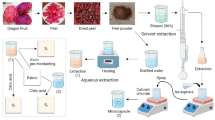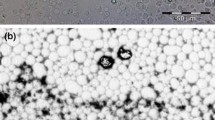Abstract
Application of encapsulated essential oils in the chemical finishing of textiles is rapidly develo** because of their versatility and flexibility. In this work, alginate nanocapsules containing peppermint oil were prepared by the microemulsion method and applied on cotton fabric by a microwave curing process. Effective parameters on antimicrobial activity of finished cotton fabric were optimized to obtain a good antimicrobial and fragrant textile. FT-IR spectroscopy and TGA were used to quantify the presence of nanocapsules on the cotton fabric. Also, the surface distribution, attendance and preferred position of the nanocapsules on the textile fibers were investigated by SEM images. The releasing behavior of peppermint oil from the finished cotton fabric in different washing cycles measured by GC-MS analysis indicated that the percent of peppermint oil reached 16 % after 25 washing cycles. Antimicrobial activity of the finished fabric showed 100 % bacterial reduction for both E. coli and S. aureus bacteria in optimum conditions.







Similar content being viewed by others
References
AATCC test method 100–2004 (2005) Antibacterial finishes on textile materials: assessment of AATCC technical manual. American Association of textile chemists and colorists, Research Triangle Park
ASTM D-1388-64 (1975) Method A: standard test method for stiffness of fabrics. ASTM, New York
Bakkali F, Averbeck S, Averbeck D, Idaomar M (2008) Biological effects of essential oils—a review. Food Chem Toxicol 46:446–475. doi:10.1016/j.fct.2007.09.106
Beristain CI, García HS, Vernon-Carter EJ (2001) Spray-dried encapsulation of cardamom (Elettaria cardamomum) essential oil with mesquite (Prosopis juliflora) gum. LWT Food Sci Technol 34:398–401. doi:10.1006/fstl.2001.0779
Bischof Vukušić S, Flinčec Grgac S, Budimir A, Kalenić S (2011) Cotton textiles modified with citric acid as efficient antibacterial agent for prevention of nosocomial infections. Croat Med J 52:68–75. doi:10.3325/cmj.2011.52.68
Bonet Aracil MÁ, Monllor P, Capablanca L, Gisbert J, Díaz P, Montava I (2015) A comparison between padding and bath exhaustion to apply microcapsules onto cotton. Cellulose 22:2117–2127. doi:10.1007/s10570-015-0600-8
Budimir A, Bischof Vukusic S, Grgac Flincec S (2012) Study of antimicrobial properties of cotton medical textiles treated with citric acid and dried/cured by microwaves. Cellulose 19:289–296. doi:10.1007/s10570-011-9614-z
Chen X, Yu J, Zhang Z, Lu C (2011) Study on structure and thermal stability properties of cellulose fibers from rice straw. Carbohydr Polym 85:245–250. doi:10.1016/j.carbpol.2011.02.022
Cristina ED (2004) Understanding true aromatherapy: understanding essential oils. Home Health Care Manag Pract 16:474–479. doi:10.1177/1084822304265851
El-Molla MM, Haggag K, El-Shall FN, Shaker NO, Alian NA (2013) Use of novel synthesized aqueous binders for pigment printing of polyester fabrics. Indian J Fibre Text Res 38:57–65
Ghayempour S, Mortazavi SM (2013) Fabrication of micro–nanocapsules by a new electrospraying method using coaxial jets and examination of effective parameters on their production. J Electrostat 71:717–727. doi:10.1016/j.elstat.2013.04.001
Ghayempour S, Mortazavi SM (2014) Antibacterial activity of peppermint fragrance micro–nanocapsules prepared with a new electrospraying method. J Essent Oil Res 26:492–498. doi:10.1080/10412905.2014.949882
Ghayempour S, Mortazavi SM (2015) Preparation and investigation of sodium alginate nanocapsules by different microemulsification devices. J Appl Polym Sci. doi:10.1002/app.41904
Heywood D (2003) Textile finishing. Society of Dyers and Colourists, Bradford
Hong K, Park S (1999) Melamine resin microcapsules containing fragrant oil: synthesis and characterization. Mater Chem Phys 58:128–131. doi:10.1016/S0254-0584(98)00263-6
Hong K, Park S (2000) Preparation of poly(l-lactide) microcapsules for fragrant fiber and their characteristics. Polymer 41:4567–4572. doi:10.1016/S0032-3861(99)00677-1
International Standard, ISO 105-C10 (2006) Textiles-Tests for colour fastness: Colour fastness to washing with soap or soap and soda. ISO, Geneva
International Standard, ISO 105-X12 (2001) Textiles-Tests for colour fastness: Colour fastness to rubbing. ISO, Geneva
Jantas R, Górna K (2006) Antibacterial finishing of cotton fabrics. Fibres Text East Eur 14:88–91
Javid A, Raza ZA, Hussain T, Rehman A (2014) Chitosan microencapsulation of various essential oils to enhance the functional properties of cotton fabric. J Microencapsul 31:461–468
Lee A, Han C, Yi E (2014) Preparation and characterization of melamine-formaldehyde microcapsules containing Citrus unshiu essential oil. Fibers Polym 15:35–40. doi:10.1007/s12221-014-0035-0
Li S, Boyter H, Qian L (2005) UV curing for encapsulated aroma finish on cotton. J Text Inst 96:407–411. doi:10.1533/joti.2005.0116
Li S, Lewis JE, Stewart NM, Qian L, Boyter H (2008) Effect of finishing methods on washing durability of microencapsulated aroma finishing. J Text Inst 99:177–183. doi:10.1080/00405000701489701
Monllor P, Bonet MA, Cases F (2007) Characterization of the behaviour of flavour microcapsules in cotton fabrics. Eur Polym J 43:2481–2490. doi:10.1016/j.eurpolymj.2007.04.004
Rajendran R, Radhai R, Kotresh TM, Csiszar E (2013) Development of antimicrobial cotton fabrics using herb loaded nanoparticles. Carbohydr Polym 91:613–617. doi:10.1016/j.carbpol.2012.08.064
Rodrigues SN, Martins IM, Fernandes IP, Gomes PB, Mata VG, Barreiro MF, Rodrigues AE (2009) Scentfashion®: microencapsulated perfumes for textile application. Chem Eng J 149:463–472. doi:10.1016/j.cej.2009.02.021
SIST-EN 12127 (1999) Determination of mass per unit area using small samples. CEN, Brussels
SIST-EN ISO 5084:1999 (1996) Determination of thickness of textiles and textile products. CEN, Brussels
Teixeira CSNR, Martins IMD, Mata VLG, Filipe Barreiro MF, Rodrigues AE (2011) Characterization and evaluation of commercial fragrance microcapsules for textile application. J Text Inst 103:269–282. doi:10.1080/00405000.2011.566312
Thilagavathi G, Krishna Bala S, Kannaian T (2007) Microencapsulation of herbal extracts for microbial resistance in healthcare textiles. Indian J Fibre Text Res 32:351–354
Wang CX, Chen SL (2005) Aromachology and its application in the textile field. Fibres Text East Eur 13:41–44
Zhao X, Min J, Jx He (2011) Effect of microwave curing on antimicrobial activity of chitosan biguanidine hydrochloride treated wool fabrics. J Text Inst 102:801–807. doi:10.1080/00405000.2010.522047
Author information
Authors and Affiliations
Corresponding author
Rights and permissions
About this article
Cite this article
Ghayempour, S., Mortazavi, S.M. Microwave curing for applying polymeric nanocapsules containing essential oils on cotton fabric to produce antimicrobial and fragrant textiles. Cellulose 22, 4065–4075 (2015). https://doi.org/10.1007/s10570-015-0765-1
Received:
Accepted:
Published:
Issue Date:
DOI: https://doi.org/10.1007/s10570-015-0765-1




